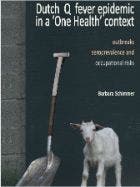Barbara Schimmer
Dutch Q fever epidemic in a ‘One Health’ context: outbreaks, seroprevalence and occupational risks

- Datum
- (Co) promotoren
- 17-04-2018
- prof.dr. R.A. Coutinho, dr. Y.T.H.P. van Duynhoven, dr. W. van der Hoek
Samenvatting
Q fever is a worldwide zoonosis caused by the bacterium Coxiella burnetii (C. burnetii). Small ruminants, in particular sheep and goats, have been associated with community Q fever outbreaks in other countries. Just prior to the Dutch Q fever epidemic, a nationwide survey indicated that only 2.4% of the Dutch population had been ever infected with C. burnetii, and this low prevalence may have contributed to the magnitude of this epidemic. In May 2007, inhabitants from a village in Noord-Brabant, were diagnosed with pneumonia, and C. burnetii was found to be the causal agent. In the following 3 years, Q fever became an important public health problem in The Netherlands, warranting a continuous enhanced surveillance and control. The epidemic curves of notified Q fever cases pointed at multiple simultaneously active sources with a clear seasonal pattern peaking in spring and early summer, following the lambing and kidding season. This thesis presents several epidemiological outbreak investigations focusing on identification of potential farm sources. GIS-based attack rate analysis turned out to be a promising tool to facilitate source detection in an outdoor environment and played an important role in implicating dairy goat farms affected by Q fever-induced abortion storms as the main source of the Dutch Q fever epidemic. This epidemic provided opportunities to gain knowledge about the nature of this zoonotic infection in several occupational groups with intensive livestock contact. In a ‘One Health’ research project, Q-VIVE, the C. burnetii seroprevalence in farm residents and on-farm herds was assessed, while farm-based and individual risk factors for C. burnetii seropositivity were identified to eventually formulate targeted advice and better control and preventive strategies. Seroprevalence figures were comparably high for residents of dairy goat farms (69%; 95%CI 63%-74%), dairy sheep farms (67% ; 95%CI 48%-82%), dairy cattle farms (72%; 95%CI 69%-75%) and livestock veterinarians (65%; 95%CI 69%-75%), and slightly lower for residents of non-dairy sheep farms (51%; 95%CI 45%-57%), indicating a high lifetime risk to acquire a C. burnetii infection. For veterinary students sampled over all study years, the overall seroprevalence was lower (19%; 95%CI 16%-22%).Both knowledge of the risk factors of C. burnetii seropositivity in infected animals and in farm residents were crucial in understanding the transmission routes and risks of human C. burnetiiinfection. For all sectors, a higher risk of infection was found for farms with a large herd size. Also farm location was a risk factor; being located in the provinces of Noord-Brabant and Limburg or in an area near small ruminant farms that tested positive in the mandatory bulk tank milk (BTM)-monitoring program. We furthermore identified several study-related and occupational risk factors associated with C. burnetii seropositivity in veterinary students and in workers involved in the culling of 50,000 sheep and goats. Among those who showed no signs of exposure to C. burnetii prior to the culling, 17.5% seroconverted for C. burnetii antibodies despite the use of personal protective equipment. Prolonged time working in close proximity to the animals was a risk factor for seroconversion.
